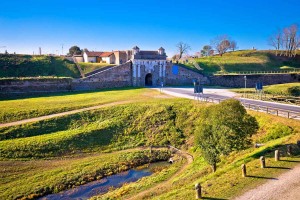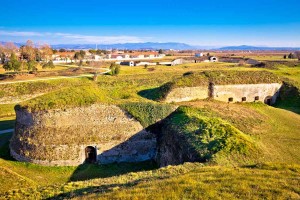
©Bigstock.com/xbrchx
The Republic of Venice was the economic power and sea power in the Mediterranean area for centuries. Being a Great Power, they controlled a major part of all trade between the continents and became a hub for all sorts of goods, for the scheming of the rich & powerful, but also a target of repeated attacks on the Republic’s special position. In order to counteract them, numerous fortifications and works of defence were established to safeguard the external borders. The Venetian Works of Defence of the 16th and 17th century stretch across three Italian regions and a total of three countries. It was declared UNESCO World Heritage Site in 2017.
Why the works of defence were necessary
Castles and fortresses are almost as old as time. People have always felt the need to protect their belongings – a natural reflex that evolved throughout history and was boosted by the constant further development of civilisation, of claims to power, arming and warfare. The Republic of Venice had always had sophisticated works of defence at its disposal, but those had to be kept up with the times.
The invention of gunpowder caused a landslide in armed conflicts. Conventional fortifications couldn’t withstand cannonballs and penetration weaponry anymore, new ideas were needed. You can probably see where this is going: Existing works of defence were massively extended and modernised in order to withstand new challenges, new fortifications were built. Extensive works of defence were established between Stato da Terra and Stato da Mar. Visiting them, they will surely impress you with their inimitable mix of extraordinary architecture, technology and fascinating history.
The three Italian sites

©Bigstock.com/xbrchx
Half of the six works of defence included on the UNESCO World Heritage Site list are located in Italy spread evenly across three regions. Travelling to each of them can take a bit of time, but that’s most certainly worth it – you should at least have an extended weekend available for this slightly unusual tour. You’d like to know where this tour would lead you, don’t you? Well, we might have an idea…
Bergamo
Bergamo in Lombardy used to serve as the westernmost outpost of the Republic of Venice and, as such, needed to be protected extensively. The city walls, their current form dating back to 1561, were expanded to an impressive six kilometres and upgraded greatly in order to withstand growing defensive requirements. In places it is up to 50 metres high and used to lead into the city through four heavily guarded gates. 14 bastions running across many a hill, two platforms and about 100 spots for pistols protected the border and were connected through an extensive network of underground corridors. Around 250 buildings were demolished for the construction of these city walls including notable cathedrals and cloisters. You probably won’t be surprised to hear that this practice caused severe conflicts with the church including several excommunications.
Peschiera del Garda
The Republic only managed to grab a hold of the small town Peschiera del Garda in Veneto in 1440. The rulers quickly realised the opportunity of building a major fortification on the shore of Lake Garda. Planned by Guidobaldo della Rovere and implemented by Michele Sanmicheli starting in 1549, it almost seems as if the ramparts were rising from the water leaning against the almost perfectly preserved historic town centre. With its earth dam reinforcements and special structures for improved artillery range, Peschiera del Garda was and is still regarded as the epitome of modern fortifications.
Palmanova
While these two sites had already existed before the Venetians attended to them, Palmanova was established solely to protect the Republic against the Ottoman Turks in the late 16th century. In addition, this planned city was set to become the Republic’s principal land base, which didn’t work – the main square, which is oversized for a small town, is evocative of such ambitions. Wide roads lead the soldiers to the town walls in the quickest way possible. Commanding officers lived in the town centre, regular soldiers around them and mercenary soldiers along the fortifications. Palmanova represents the perfect fortress town and, as such, is included on the UNESCO World Heritage list.
Venetian Works of Defence outside Italy
It goes without saying that we focus on the Venetian Works of Defence located in Italy. Still, we’d love to give you a brief overview of those in Croatia and Montenegro:
- Zadar (Croatia): The port city at the Adriatic Sea fell to the Republic of Venice as early as 1409. As the Ottoman Turks were starting their conquering expeditions in the hinterland, massive fortification structures were developed in the early 16th A special moat off the coast protects the city as do several gates and ramparts.
- Nicholas in Šibenik (Croatia): Šibenik, known for its very own UNESCO World Heritage Site, the Cathedral of St. James, is situated a bit further south where the river Krka flows into the Adriatic Sea. There are a whopping four Venetian fortifications, of which St. Nicholas Fortress, located at the entrance of St. Anthony Channel, was included in this very UNESCO World Heritage collection.
- Kotor (Montenegro): Originally an important centre of trade and flourishing competitor to the Republic itself, Kotor gradually lost its independence under Venetian protection. The impressive city walls were fully modernised and extended greatly along its entire length of 4.5 km. They now virtually flow into the eponymous Bay of Kotor.
Special case: The Venetian lagoon
According to original plans, even more towns were set to be included in this UNESCO World Heritage Site: Hvar, Korčula and all of Šibenik in Croatia, Herceg Novi and Ulcinj in Montenegro. They weren’t put on the final list, same as the Venetian lagoon, which we believe to be a special case. It is the site of several octagonal fortifications, the Venetian Arsenal, Fort San Felice and Fort Sant’Andrea. It is unknown why this impressive region wasn’t included. However, it is already part of the UNESCO World Heritage Site “Venice and its lagoon” and actually has been since 1987. Maybe the people responsible tried to avoid a double inclusion, yet the giant works of defence would’ve certainly been deserving.
Innovative and revolutionary for their time, still mighty impressive and, above all, mostly well-preserved: The Venetian Works of Defence of the 16th and 17th century continue to amaze to this very day, even if your interest in military history is limited at best. We wish you lots of fun for this round tour through Northern Italy and cannot recommend a trip to the lagoons and to other World Heritage Sites at the Adriatic Sea highly enough!